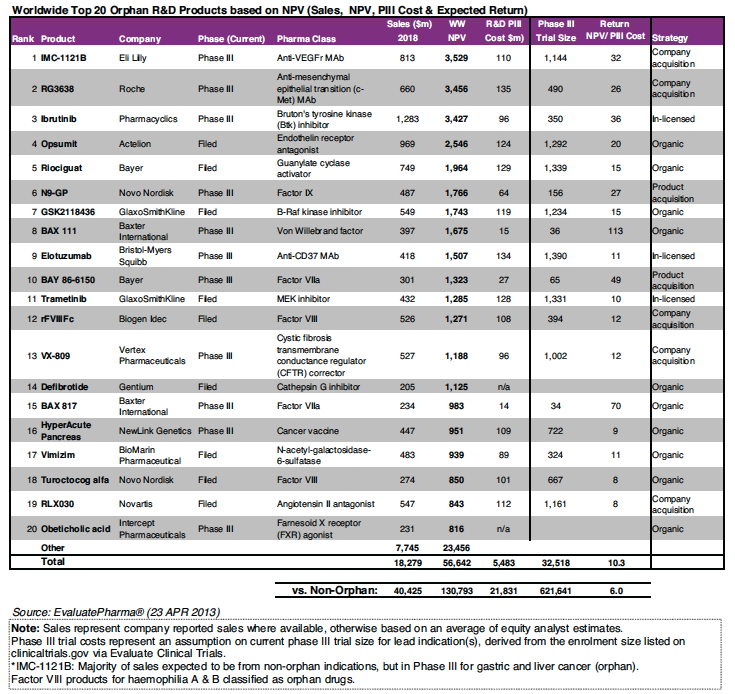PharmExec's Orphan Drug Pipeline Picks
Orphan drugs were given short shrift in PharmExec’s 2014 Pipeline Report, but a couple of pipeline candidates targeting small populations did make the list, and are expected to earn big dollars in the next few years.
Orphan drugs were given short shrift in PharmExec’s 2014 Pipeline Report, but a couple of pipeline candidates targeting small populations did make the list, and are expected to earn big dollars in the next few years.
In the US, private and government payers haven’t yet had the nerve to balk at rare disease drug prices. The drug industry argument is working: how much would it cost to provide care to these patients without a working, sometimes curative treatment? Alexion Pharmaceuticals’ chief commercial officer, David Hallal, told PharmExec in September that patient outcomes justify the company’s $400,000 price tag for Soliris, a drug indicated for two ultra rare conditions. “The approvals from the regulatory authorities highlight that there’s a 100 percent objective response rate in our clinical trials for both conditions,” says Hallal. “Such transformative outcomes highlight what we think clearly support our narrow pricing band.”
As long as payers keep supporting a “narrow pricing band” for orphan drugs, the argument goes, companies will keep developing drugs for small patient populations and rare diseases. If payers stopped paying, companies would move on to other high-ROI therapeutic categories, and stop worrying about patients with obscure conditions. Assuming this orphan disease homeostatic harmony between industry and payers is maintained at least in the short run, the following products, covered in this year’s forthcoming Pipeline Report, are likely to bring in sizeable returns for their parent companies:
• Synageva Biopharma’s sebelipase alfa is in phase 3 testing for the treatment of Wolman disease, a rare lysosomal storage disorder in which patients are unable to break down certain fats. Infants with the disease often die, and adults have problems with swelling of the abdomen, liver enlargement and serious, life-threatening digestive problems, in addition to calcification of the adrenal glands, which effects hormone production (which in turn effects other key processes like metabolism, blood pressure and the immune system). Sebelipase alfa would become the first approved treatment for Wolman disease, and the FDA has granted Orphan Drug, Fast Track and Breakthrough Therapies status. Since payers, patients and the public at large tend to especially like treatments for diseases where none previously existed, Synageva Biopharma could be rewarded handsomely for sebelipase alfa.
• Eli Lilly had to can a 1,144 Eli Lilly had to can a 1,144 patient multinational phase 3 study on ramucirumab, a VEGF antiangiogenic monoclonal antibody for breast cancer in September, but there’s a silver lining. Ramucirumab received an FDA Fast Track designation for gastric cancer, and a Priority Review in October. In Australia, ramucirumab picked up an orphan designation for advanced gastric cancer, an area “of high unmet need…if you can prolong survival then I think [Lilly] has got a very good option for those patients,” says Kiran Meekings, a consultant on the Thomson Reuters Life Sciences team. Interestingly, ramucirumab targets the VEGF receptor, whereas Avastin targets the ligand. Avastin failed in phase 3 trials for gastric cancer, which raises the question: is there a true mechanistic difference in targeting the receptor versus the ligand? If so, “these angiogenics will start to separate themselves in terms of where they might be active,” says Hawthorne. Sanofi/Regeneron haven’t publicly announced plans to test Zaltrap in gastric cancer, but ClinicalTrial.gov shows enrollment for a phase 2 study of Zaltrap for esophagogastric cancer, which a malignancy in the throat as opposed to the stomach. Gastric cancer incidence in Japan has risen sharply in recent years; Decision Resources says the global gastric cancer market will reach $2.3 billion by 2021, with 44% of those revenues coming from Japan. Thomson Reuters pegs ramucirumab sales at $725 million by 2018, and Evaluate Pharma (see below) predicts $813 million in sales by 2018. (IMC-1121B is also known as ramucirumab.)
• Another late-stage, big return orphan candidate covered in PharmExec’s previous 2012 Pipeline Report is BioMarin’s VimiZin, formerly known as GALNS, for treatment for Morquio A syndrome. VimiZim will get an FDA Advisory Committee review on November 19, and its PDUFA date is February 28, 2014. A favorite of Evaluate Pharma (see below), Thomson Reuters Cortellis predicts VimiZim sales to reach just over half a billion by 2019.
Evaluate Pharma’s (EP) top 20 orphan drug picks in the pipeline, measured by Net Present Value (NPV), are listed below for your consideration. EP’s picks and figures were compiled in April 2013, as part of a report on orphan drugs. We appreciate EP’s permission to reproduce them here.

Beyond the Prescription: Pharma's Role in Digital Health Conversations
April 1st 2025Join us for an insightful conversation with Jennifer Harakal, Head of Regulatory Affairs at Canopy Life Sciences, as we unpack the evolving intersection of social media and healthcare decisions. Discover how pharmaceutical companies can navigate regulatory challenges while meaningfully engaging with consumers in digital spaces. Jennifer shares expert strategies for responsible marketing, working with influencers, and creating educational content that bridges the gap between patients and healthcare providers. A must-listen for pharma marketers looking to build trust and compliance in today's social media landscape.
Talphera Cuts NEPHRO CRRT Study Size, Secures $14.8 Million Private Placement
April 1st 2025The trial size adjustment, along with protocol modifications and the addition of higher-enrollment sites, is expected to facilitate completion of the NEPHRO CRRT study of Niyad in patients undergoing renal replacement therapy by the end of 2025.